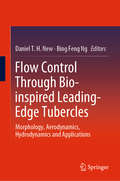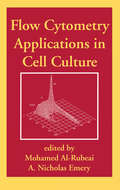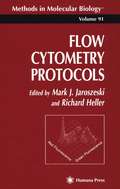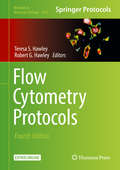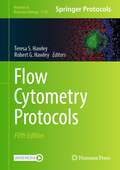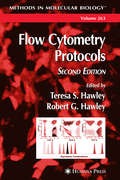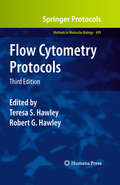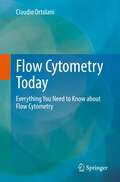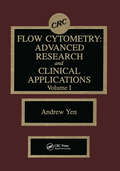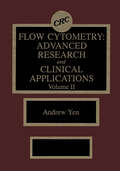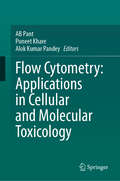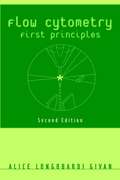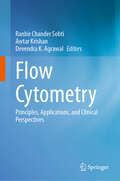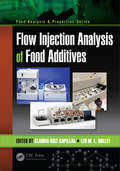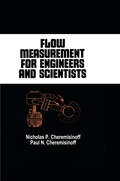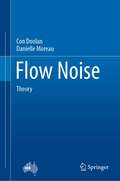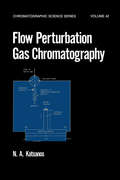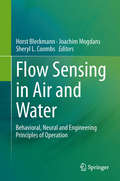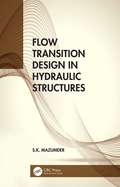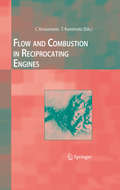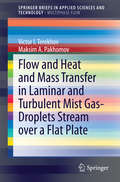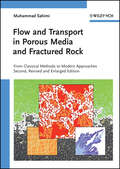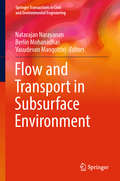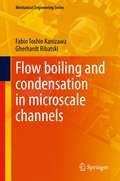- Table View
- List View
Flow Control Through Bio-inspired Leading-Edge Tubercles: Morphology, Aerodynamics, Hydrodynamics and Applications
by Daniel T. H. New Bing Feng NgThis book describes and explains the basis of bio-inspired, leading-edge tubercles based on humpback whale flippers as passive but effective flow control devices, as well as providing a comprehensive practical guide in their applications. It first discusses the morphology of the humpback whale flipper from a biological perspective, before presenting detailed experimental and numerical findings from past investigations by various experts on the benefits of leading-edge tubercles and their engineering implementations.Leading-edge tubercle designs and functions have attracted considerable interest from researchers in terms of understanding their role in the underwater agility of these whales, and to exploit their flow dynamics in the development of new and novel engineering solutions. Extensive research over the past recent years has demonstrated that the maneuverability of these whales is at least in part due to the leading-edge tubercles acting as passive flow control devices to delay stall and increase lift in the post-stall regime. In addition to the inherent benefits in terms of aerodynamics and hydrodynamics, investigations into leading-edge tubercles have also broadened into areas of noise attenuation, stability and industrial applications.This book touches upon these areas, with an emphasis upon the effects of lifting-surface types, flow regimes, tubercle geometries, lifting-surface stability and potential industrial applications, among others. As such, it features contributions from key experts in the fields of biology, physics and engineering who have conducted significant studies into understanding the various aspects of leading-edge tubercles. Given the broad coverage and in-depth analysis, this book will benefit academic researchers, practicing engineers and graduate students interested in tapping into such a unique but highly functional flow control strategy.
Flow Cytometry Applications in Cell Culture
by Mohamed Al-RubeaiThis work present practical, biotechnological applications of flow cytometry techniques for the study of animal, plant and microbial cells, explaining methodologies for sample preparation, staining and analysis. It discusses cell variability in cell culture processes and shows how the quantitative analysis of heterogeneous populations aids in the biotechnological exploitation of cells.
Flow Cytometry Protocols
by Richard Heller Mark J. JaroszeskiIn addition to providing chapters on the theoretical and practical aspects of flow cytometry, this book contains protocols used specifically for immediate use in the diagnostic and experimental measurements enabled by modern flow cytometric instrumentation. Research protocols cover cell cycle analysis and regulation, detection of rare cells, solid tumor DNA techniques, ploidy analysis and the application of flow cytometric methods for measurements of leukemias, necrosis, apoptosis, heat shock proteins, liver and bladder cancer, disease monitoring, and intracellular measurements. Hematologic and immunologic applications are also described by researchers with a particular expertise in their use. A special section is included for biotechnologists using flow cytometry in the study of protein secretion, the monitoring of fermentation processes, monitoring bioreactors, cell-cell electroporation, quantitation electrofusion, and electrochemotherapy.
Flow Cytometry Protocols
by Robert G. Hawley Teresa S. HawleyFlow cytometry has evolved since the 1940s into a multidisciplinary field incorporating aspects of laser technology, fluid dynamics, electronics, optics, computer science, physics, chemistry, biology, and mathematics. Innovations in instrumentation, development of small lasers, discovery of new fluorochromes/fluorescent proteins, and implementation of novel methodologies have all contributed to the recent rapid expansion of flow cytometry applications. In this thoroughly revised and updated second edition of Flow Cytometry Protocols, time-proven as well as cutting-edge methods are clearly and comprehensively presented by leading experimentalists. In addition to being a valuable reference manual for experienced flow cytometrists, the editors expect this authoritative up-to-date collection to prove useful to investigators in all areas of the biological and biomedical sciences who are new to the subject. The introductory chapter provides an eloquent synopsis of the principles and diverse uses of flow cytometry, beginning with a historical perspective and ending with a view to the future. Chapters 2-22 contain step-by-step protocols of highly practical and state-of-the-art techniques. Detailed instructions and helpful tips on experimental design, as well as selection of reagents and data analysis tools, will allow researchers to readily carry out flow cytometric investigations ranging from traditional phenotypic characterizations to emerging genomics and proteomics applications. Complementing these instructive protocols is a chapter that provides a preview of the next generation of solid-state lasers, and one that describes a rapid means to validate containment of infectious aerosols generated during high-speed sorting (Chapters 23-24).
Flow Cytometry Protocols (Methods in Molecular Biology #2779)
by Robert G. Hawley Teresa S. HawleyThis fifth edition volume expands on the previous editions by presenting readers with the latest developments and emerging methodologies in cytometry. The chapters in this book cover cytometry basics such as lasers for cytometry, metrics that can be used to evaluate spillover spreading, and the process of panel design and iterative optimization for spectral flow cytometry; novel methodologies such as image-enabled cell sorting, co-staining of fluorochrome-conjugated and oligonucleotide-conjugated antibodies, and screening for cell type selective probes; and a look at the achievements made in the clinical setting for both flow and mass cytometry. Written in the highly successful Methods in Molecular Biology series format, chapters include introductions to their respective topics, lists of the necessary materials and reagents, readily reproducible step-by-step laboratory protocols, and tips on troubleshooting and avoiding known pitfalls.Cutting-edge and comprehensive, Flow Cytometry Protocols, Fifth Edition is a valuable resource for researchers and scientists who are interested in continuing or expanding their knowledge of this developing field.
Flow Cytometry Protocols, 2nd Edition
by Robert G. Hawley Teresa S. HawleyThis thoroughly revised and updated edition of a widely used practical guide to flow cytometry describes in step-by-step detail an array of time proven and cutting-edge techniques much needed in today's advanced laboratories. These readily reproducible methods deploy emerging flow cytometry technologies in many new applications, especially in the field of stem cells, functional genomics and proteomics, and microbiology. Here, the aspiring investigator will find methods for the characterization of stem/progenitor cells by monitoring the efflux of fluorescent dyes and the elucidation of signal transduction pathways using phospho-specific antibodies. There are also techniques for monitoring gene transfer and expression using fluorescent protein technology, high throughput screening for discovery of novel protein interactions, phenotypic and functional characterization of T cell subsets and precursors, and microbial flow cytometry, to highlight but some of the many useful procedures.
Flow Cytometry Protocols, 3rd Edition
by Robert G. Hawley Teresa S. HawleyWith rapid improvements in instrumentation, lasers, fluorophores, and data analysis software, flow cytometry is riding the crest of unprecedented, innovative advances. This thoroughly revised and up-to-date third edition of Flow Cytometry Protocols highlights the expanding contribution of flow cytometry to basic biological research and diagnostic medicine. Written by leading experts in the field, the book presents cutting-edge topics such as polychromatic, quantitative, and high throughput flow cytometry, novel multiparametric data analysis which breaks the dimensionality barrier, standard practice and safety measures for aerosol-generating cell sorting, conventional and imaging flow cytometry as well as minimalist imaging cytometry. As a volume in the highly successful Methods in Molecular Biology™ series, chapters contain brief introductions to their respective topics, lists of the necessary materials and reagents, step-by-step, readily reproducible laboratory protocols, and extensive notes on troubleshooting and avoiding known pitfalls. Authoritative and comprehensive, Flow Cytometry Protocols, Third Edition presents established as well as new flow cytometric methodologies in order to introduce beginning users to basic applications while opening new avenues of innovation for seasoned users.
Flow Cytometry Today: Everything You Need to Know about Flow Cytometry
by Claudio OrtolaniThis book covers all the technical aspects of flow cytometry needed to set-up the instrument, solve problems encountered in daily work, or necessary for exam preparation. It provides the reader with an in-depth look at the device and its applications. Each component and its function is described in an easy-to-understand manner, giving the reader a sound basic knowledge of this instrument. The practical examples given, simplify and enhance the learning process. This book is a unique resource of knowledge for biomedical engineers and biotechnologists, flow cytometry operators, laboratory technicians and biomedical researchers, both biologists as well as medical doctors, and can also be a helpful tool for companies and manufacturers.
Flow Cytometry: Advanced Research and Clinical Applications, Volume I
by Andrew YenThe current technology and its applications in flow cytometry are presented in this comprehensive reference work. Described in explicit detail are the instrumentation and its components, and applications of the technology in cell biology, immunology, pharmacology, genetics, hematology and clinical medicine. Methods for data analysis, including both hardware and software, and explicit experimental techniques for making specific measurements are presented.Material is divided by topic into two volumes: Volume I covers instrumentation, genetics, and cell structure; Volume II contains material on cell function studies by flow cytometry.This reference is essential for both the novice and the experienced investigator using flow cytometry in research, and for students of cell biology, biomedical engineering, and medical technology.
Flow Cytometry: Advanced Research and Clinical Applications, Volume II
by Andrew YenThe current technology and its applications in flow cytometry are presented in this comprehensive reference work. Described in explicit detail are the instrumentation and its components, and applications of the technology in cell biology, immunology, pharmacology, genetics, hematology and clinical medicine. Methods for data analysis, including both hardware and software, and explicit experimental techniques for making specific measurements are presented.Material is divided by topic into two volumes: Volume I covers instrumentation, genetics, and cell structure; Volume II contains material on cell function studies by flow cytometry.This reference is essential for both the novice and the experienced investigator using flow cytometry in research, and for students of cell biology, biomedical engineering, and medical technology.
Flow Cytometry: Applications in Cellular and Molecular Toxicology
by Ab Pant Puneet Khare Alok Kumar PandeyThe book explores the role of flow cytometry in varied fields, from clinical diagnosis to toxicology. This comprehensive book offers insights into biomarkers, cellular analysis, and safety evaluations. Organized into fifteen chapters, this book explores flowcytometry's historical journey, scientific validation, and implementation in toxicity studies with case studies, technical and applied approaches, pictorial representations, informative tables, and simple language, It will be an invaluable resource for researchers, academia, biopharma industries, graduate and postgraduate students, Ph.D., and post-doctoral fellows working in the fields of toxicology/biosafety, and biomedical research.
Flow Cytometry: First Principles
by Alice Longobardi GivanFlow cytometry continually amazes scientists with its ever-expanding utility. Advances in flow cytometry have opened new directions in theoretical science, clinical diagnosis, and medical practice. The new edition of Flow Cytometry: First Principles provides a thorough update of this now classic text, reflecting innovations in the field while outlining the fundamental elements of instrumentation, sample preparation, and data analysis. Flow Cytometry: First Principles, Second Edition explains the basic principles of flow cytometry, surveying its primary scientific and clinical applications and highlighting state-of-the-art techniques at the frontiers of research. This edition contains extensive revisions of all chapters, including new discussions on fluorochrome and laser options for multicolor analysis, an additionalsection on apoptosis in the chapter on DNA, and new chapters onintracellular protein staining and cell sorting, including high-speed sorting and alternative sorting methods, as well as traditional technology. This essential resource: Assumes no prior knowledge of flow cytometry Progresses with an informal, engaging lecture style from simpleto more complex concepts Offers a clear introduction to new vocabulary, principles of instrumentation, and strategies for data analysis Emphasizes the theory relevant to all flow cytometry, with examples from a variety of clinical and scientific fields Flow Cytometry: First Principles, Second Edition provides scientists, clinicians, technologists, and students with the knowledge necessary for beginning the practice of flow cytometry and for understanding related literature.
Flow Cytometry: Principles, Applications, and Clinical Perspectives
by Awtar Krishan Ranbir Chander Sobti Devendra K. AgrawalFlow cytometry is a state-of-the-art technology that is widely used in biological research and clinical diagnostics. It is a high-throughput platform that allows the quantification, differentiation, and functional study of cells or cell like particles in suspension. Various cell components can be targeted with fluorescently labelled antibodies or fluorescent dyes to allow measurement and analysis of the physical, chemical, and biological properties of individual cells within homogenous or heterogeneous populations. Since its commercialization more than five decades ago, flow cytometry has advanced and become an very important analytical tool in translational research. With the advancement of instrument technology, an increasing number of fluorescent dyes, and an expanding range of monoclonal antibodies, the applications of flow cytometry in applied research continue to grow. The use of multiparametric flow cytometry in translational research provides the ability to rapidly identify different cell populations and to simultaneously measure multiple parameters of single cells for efficiently assessing immune status, decrease/increase of specific immune cell populations, cell activation status, etc. of different cells in preclinical and clinical studies. The primary goal of any research work is to take research results from the "bench to-bed and back". The use of flow cytometry in applied research advances the development of new diagnostic tests or drugs for cancer treatment, immune monitoring, etc. that help in patient care. Today, every biological scientist needs to have basic knowledge of flow cytometry in order to utilise this technology properly in their own research and to understand other’s research work. The present book has been designed to give the knowledge of flow cytometry and its applications to the researchers and teachers. It will allow the readers to utilize the technology in an appropriate way in their research work. This book has describing various applications of flow cytometry like cell health monitoring, immunophenotyping, cell sorting, stem cell characterization, micro-vesicle analysis etc.
Flow Injection Analysis of Food Additives (Food Analysis & Properties)
by Leo M. L. NolletFlow Injection Analysis of Food Additives gives you the tools you need to analyze food and beverage additives using FIA. This sets it apart from other books that simply focus on the theoretical basis and principles of FIA or on the design of equipment, instrumentation, manifold, and setting mechanism. Truly unprecedented in its scope, this book rep
Flow Measurement for Engineers and Scientists (Chemical Industries Ser. #32)
by Nicholas P. Cheremisinoff Paul N. CheremisinoffThis book discusses instrumentation and experimental methods for obtaining detailed information on the structure of various types of flows as well as standard process flow instrumentation suitable for industrial control applications. It assists research-oriented and process engineering personnel.
Flow Noise: Theory
by Danielle Moreau Con DoolanThis book highlights the importance of sound produced by fluid flow or flow-induced noise. Noise created by unsteady flow creates high levels of environmental noise pollution, a known public health problem, and can compromise the acoustic qualities of marine vessels. There is a seemingly ever-growing list of modern technology that created flow-induced noise which includes aircraft, wind turbines, submarines, drones, high-speed rail, and cooling fans. More scientists and engineers are required to incorporate the effects of flow-induced noise in their work. This book also provides a comprehensive introduction to the theory underpinning the understanding of flow-induced noise.
Flow Perturbation Gas Chromatography
by A. KatsanosThis book discusses flow perturbation method, namely, the stopped-flow technique and the reversed-flow technique. It is directed to those who need an accurate method for the determination of a certain physicochemical quantity and to researchers working on the development of gas chromatography.
Flow Sensing in Air and Water
by Horst Bleckmann Joachim Mogdans Sheryl L. CoombsIn this book, leading scientists in the fields of sensory biology, neuroscience, physics and engineering explore the basic operational principles and behavioral uses of flow sensing in animals and how they might be applied to engineering applications such as autonomous control of underwater or aerial vehicles. Although humans possess no flow-sensing abilities, countless aquatic (e. g. fish, cephalopods and seals), terrestrial (e. g. crickets and spiders) and aerial (e. g. bats) animals have flow sensing abilities that underlie remarkable behavioral feats. These include the ability to follow silent hydrodynamic trails long after the trailblazer has left the scene, to form hydrodynamic images of their environment in total darkness, and to swim or fly efficiently and effortlessly in the face of destabilizing currents and winds.
Flow Transition Design in Hydraulic Structures
by S.K. MazumderTransitions are provided in hydraulic structures for economy and efficiency. This book covers all types of flow transitions: sub-critical to sub-critical, sub-critical to super critical, super-critical to sub-critical with hydraulic jump, and super-critical to super-critical transitions. It begins with an introduction followed by characteristics of flow in different types of transitions and procedures for hydraulic design of transitions in different structures. Different types of appurtenances used to control flow separation and ensure uniform flow at exit of transition and diffusers are included. Examples of hydraulic design of a few typical hydraulic structures are given as well.
Flow and Combustion in Advanced Gas Turbine Combustors
by Michael Schäfer Amsini Sadiki Christof Heeger Johannes JanickaWith regard to both the environmental sustainability and operating efficiency demands, modern combustion research has to face two main objectives, the optimization of combustion efficiency and the reduction of pollutants. This book reports on the combustion research activities carried out within the Collaborative Research Center (SFB) 568 "Flow and Combustion in Future Gas Turbine Combustion Chambers" funded by the German Research Foundation (DFG). This aimed at designing a completely integrated modeling and numerical simulation of the occurring very complex, coupled and interacting physico-chemical processes, such as turbulent heat and mass transport, single or multi-phase flows phenomena, chemical reactions/combustion and radiation, able to support the development of advanced gas turbine chamber concepts
Flow and Combustion in Reciprocating Engines
by Take Kamimoto C. ArcoumanisOptimization of combustion processes in automotive engines is a key factor in reducing fuel consumption. This book, written by eminent university and industry researchers, investigates and describes flow and combustion processes in diesel and gasoline engines.
Flow and Heat and Mass Transfer in Laminar and Turbulent Mist Gas-Droplets Stream over a Flat Plate
by Victor I. Terekhov Maksim A. PakhomovIn this book the author presents selected challenges of thermal-hydraulics modeling of two-phase flows in minichannels with change of phase. These encompass the common modeling of flow boiling and flow condensation using the same expression. Approaches to model these two respective cases show, however, that experimental data show different results to those obtained by methods of calculation of heat transfer coefficient for respective cases. Partially that can be devoted to the fact that there are non-adiabatic effects present in both types of phase change phenomena which modify the pressure drop due to friction, responsible for appropriate modelling. The modification of interface shear stresses between flow boiling and flow condensation in case of annular flow structure may be considered through incorporation of the so called blowing parameter, which differentiates between these two modes of heat transfer. On the other hand, in case of bubbly flows, the generation of bubbles also modifies the friction pressure drop by the influence of heat flux. Presented are also the results of a peculiar M-shape distribution of heat transfer coefficient specific to flow boiling in minichannels. Finally, some attention is devoted to mathematical modeling of dryout phenomena. A five equation model enabling determination of the dryout location is presented, where the mass balance equations for liquid film, droplets and gas are supplemented by momentum equations for liquid film and two-phase core.
Flow and Transport in Porous Media and Fractured Rock: From Classical Methods to Modern Approaches
by Muhammad SahimiIn this standard reference of the field, theoretical and experimental approaches to flow, hydrodynamic dispersion, and miscible displacements in porous media and fractured rock are considered. Two different approaches are discussed and contrasted with each other. The first approach is based on the classical equations of flow and transport, called 'continuum models'. The second approach is based on modern methods of statistical physics of disordered media; that is, on 'discrete models', which have become increasingly popular over the past 15 years. The book is unique in its scope, since (1) there is currently no book that compares the two approaches, and covers all important aspects of porous media problems; and (2) includes discussion of fractured rocks, which so far has been treated as a separate subject. Portions of the book would be suitable for an advanced undergraduate course. The book will be ideal for graduate courses on the subject, and can be used by chemical, petroleum, civil, environmental engineers, and geologists, as well as physicists, applied physicist and allied scientists that deal with various porous media problems.
Flow and Transport in Subsurface Environment (Springer Transactions in Civil and Environmental Engineering)
by Natarajan Narayanan Berlin Mohanadhas Vasudevan MangottiriThis book presents a collection of contributions from experts working on flow and transport in porous media around the globe. The book includes chapters authored by engineers, scientists, and mathematicians on single and multiphase flow and transport in homogeneous as well as heterogeneous porous media. Addressing various experimental, analytical, and modeling aspects of transport in sub-surface domains, the book offers a valuable resource for graduate students, researchers, and professionals alike.
Flow boiling and condensation in microscale channels (Mechanical Engineering Series)
by Fabio Toshio Kanizawa Gherhardt RibatskiThis book covers aspects of multiphase flow and heat transfer during phase change processes, focusing on boiling and condensation in microscale channels. The authors present up-to-date predictive methods for flow pattern, void fraction, pressure drop, heat transfer coefficient and critical heat flux, pointing out the range of operational conditions that each method is valid. The first four chapters are dedicated on the motivation to study multiphase flow and heat transfer during phase change process, and the three last chapters are focused on the analysis of heat transfer process during boiling and condensation. During the description of the models and predictive methods, the trends are discussed and compared with experimental findings.
